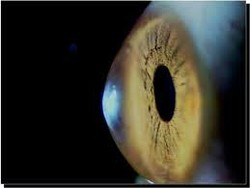Keratoconus is a type of eye ailment where the cornea thins progressively. The natural shape of the cornea is round; however, this disease gradually changes it to a conical shape, which distorts the light's focus before it falls on the retina.

Keratoconus - Causes and Treatments
by CRfan
Keratoconus is a disease of the cornea where it progressively thins and bulges in a cone shape. It can lead to progressive vision loss.
What Causes Keratoconus
Although, Keratoconus is not caused by anything definitive, there are certain factors that can make a person susceptible to this disease.
Rubbing the Eye:
People suffering from Keratoconus, usually have a history of rubbing their eye vigorously.
Wearing Gas Permeable Contact Lenses:
People wearing this type of lens have shown greater susceptibility to Keratoconus. However, it is still debated, whether the lens causes Keratoconus, or the condition existed before wearing this lens.
Atopic Disease:
Individuals having atopic disease like severe allergies and asthma, which requires steroid injections, are more at risk of getting keratoconus.
Hormones:
Keratoconus advances at a higher rate during pregnancy, and during adolescence.
Genetics:
Studies have shown that there is higher incidence of this disease amongst family members, twins, and individuals suffering from Down syndrome.
Overall, the risk of getting Keratoconus is considered to be in the range of 2 to 86 people, out of 100,000.
Keratoconus Symptoms and Signs
Individuals having keratoconus may not be diagnosed of their condition for a long time. Such people usually show symptoms of light sensitivity, and distorted or blurry vision. When the condition of the cornea worsens, these people become exceedingly nearsighted and suffer higher levels astigmatism.
Keratoconus Treatment
Most keratoconic patients are benefitted by just wearing glasses. However, with the progression of this disease, glasses cannot deliver 20/20 vision. Glasses, although remains the preferred treatment, when the patient is able to function and drive as per normal standards.
Soft Toric Contact Lenses
These lenses are ideal, when keratoconus is in its early stages. Air Optix and Advance Acuvue for Astigmatism are popular choices for toric lenses; however, if these are not available in the required high powers, then there are other options as well.
Gas Permeable Contact Lenses
"Hard" or gas permeable types of lenses are usually recommended for individuals suffering from keratonconus. While wearing these lenses, tears are sandwiched between the lens rear and cornea, and this layer itself behaves like a lens, which helps in smoothening astigmatism irregularities of keratoconus. Quite a few people have benefitted with standard lenses of this type.
Specialty Gas Permeable Contact Lenses
With advanced state of keratoconus, standard lenses of gas permeable type, start rubbing on the cornea's tip. This has the potential to cause abrasion, pain, and scarring. Specialty type of lenses, have a pocket that helps in clearing conical hump of the cornea, which helps in avoiding damage to the eye. The lens with Rose K design was the first of this kind, and is even now the popular design. It gets its name from Paul Rose, who was the optometrist in New Zealand, who designed it. Many labs manufacturing contact lens now have adaptations of Rose K design, and Ikone lens is another famous design.
Semi-Scleral and Scleral Lenses
These lenses are not quite common, as they have to be fitted correctly by an optometrist. Scleral lens works on the principle of vaulting the full cone of the cornea, and irregularities are corrected with the tear formation on the underside of the lens. This is a large lens and it covers part of the eye white as well.
Hybrid Lenses
SynergEyes is the only company making Hybrid lenses now. The center of this lens is gas permeable, and it has a skirting of soft lens. It combines the soft lens comfort, and gas permeability provides better optics. Another lens called ClearKone provides better optics and comfort; however, it is quite expensive, and is harder to remove and insert than others.
Piggyback Lenses
These are a set of two lenses. It comprises of one soft lens that is placed on the cornea, and another lens of gas permeable type that is placed on the soft one. The soft lens placement results in a cushioning effect on the cornea, and the gas permeable one, is helpful to correct the vision. People wearing gas permeable type of lenses can switch intermittently to piggyback lenses, when their usual lenses feel uncomfortable, or start to rub against the cornea.
Intacs
These small inserts require embedding in the cornea, by which the cornea is propped up, and has a better regular surface. It is quite a quick procedure, and is known to provide good results for people having keratoconus, who use contacts or glasses. It is not a cure for keratoconus, but it can delay a corneal transplant requirement.
Cornea Transplant
This is the last resort and usually done when keratoconus is in the final stages. The procedure involves, surgically removing the cornea, and sewing in a new cornea from a donor. The healing can take a long time, even more than a year, and success is not guaranteed. Usually the irregularity of the new cornea will require wearing of specialty lenses.
Corneal Crosslinking
In this procedure, riboflavin solution is exposed to certain UV light wavelengths to make it bond with the cornea and strengthen it, so that further steepening and deformation is arrested. There are two ways of doing this procedure. In the first, the cornea's top layer (epithelium) is removed and riboflavin is applied directly to the middle layer (stroma). In the other technique, riboflavin is applied on the epithelium, and is activated after some time, when it has penetrated to the stroma. Both techniques are effective, but when the epithelium is not removed, there is less pain and healing is quicker.
You might also like
How to React to and Help a Loved One with CancerDealing with cancer? Learn how to react, treat and care for a loved one when ...
Do You Have Your Own Cure For Cancer?Is it possible you might be completely unaware of the cancer cure, a natural ...




 How The FDA Approves New Medicineson 08/16/2013
How The FDA Approves New Medicineson 08/16/2013
 10 Tax Mistakes Business Owners Makeon 08/05/2013
10 Tax Mistakes Business Owners Makeon 08/05/2013
 Accessories For Traveling With Jeweleryon 02/12/2013
Accessories For Traveling With Jeweleryon 02/12/2013
 Stages of the Sleep Cycleon 09/23/2012
Stages of the Sleep Cycleon 09/23/2012


Comments